par Eskay Mining Corp. (isin : CA2964371066)
Eskay Mining Presents New Geophysical Interpretation of its Data and Welcomes Riaz Mirza as Geophysical Advisor in its Quest to Discover Precious Metal-Rich VMS Deposits Across its Consolidated Eskay Project, Golden Triangle, BC
TORONTO, ON / ACCESSWIRE / March 13, 2023 / Eskay Mining Corp. ("Eskay" or the "Company") (TSX-V:ESK)(OTCQX: ESKYF)(Frankfurt:KN7)(WKN:A0YDPM) is pleased to announce the addition of Mr. Riaz Mirza, M.Sc., as Geophysical Advisor to its exploration team. Mr. Mirza brings a wealth of experience in the application of geophysics for precious- and base-metal exploration in the Golden Triangle where he has been actively engaged in numerous projects over the past decade. Eskay Mining welcomes Mr. Mirza as the newest member of its world-class team of explorers in search of "Eskay Creek V2.0."
Riaz Mirza, founder of Simcoe Geoscience Limited, a global geophysical service provider, has significant experience exploring a variety of deposit types including volcanogenic massive sulfide ("VMS") deposits across the Golden Triangle, British Columbia. This experience, as well as Simcoe's reliance on "next-generation" geophysical data collection and processing, provides Eskay Mining with an entirely new set of tools with which to define new exploration targets for future drill testing.
Mac Balkam, CEO of Eskay Mining, commented: "Riaz and his team have been reviewing our geophysical data from our 100% controlled 602.55 sq km Consolidated Eskay project area with the goal of drawing direct comparisons to that from the original Eskay Creek precious metal-rich VMS deposit. Because VMS deposits typically occur in clusters, drawing direct comparisons of our data to that of our neighbor provides a huge step forward in our quest for discovering ‘Eskay Creek V2.0.'"
John DeDecker, VP of Exploration for Eskay Mining, commented: "Using our large geophysical database, Riaz and his team immediately identified some compelling similarities between the amplitude, texture, distribution and depth of magnetic anomalies associated with the Eskay Creek deposit and multiple areas displaying such patterns across our Consolidated Eskay project. This very distinct magnetic signature associated with the ore bodies at Eskay Creek gives us a powerful tool with which to identify new VMS targets. Combined with our BLEG, rock chip, and soil geochemical data, we now have the ability to undertake much more tightly focused exploration work in 2023."
Riaz Mirza, Geophysical Advisor to Eskay Mining, noted: "We here at Simcoe Geoscience have already been able to use Eskay Mining's existing data to illuminate further potential VMS targets. Key magnetic signatures observed at the Eskay Creek deposit are visible in multiple locations across the Consolidated Eskay project telling us we have excellent discovery potential. With this work, Eskay will be able to better use its 2023 exploration budget by targeting its drilling more effectively. We here at Simcoe look forward to teaming up with Eskay's technical team to strategize our next approaches to exploration including focused mapping, sampling, drilling and perhaps other approaches across Eskay's large land holdings. We thank Eskay Mining's for the opportunity to work with their strong technical team as we pursue discovery of ‘Eskay Creek V2.0.'"
Data, Methodology and Interpretation by Simcoe Geoscience
- A Leapfrog model of mineralization at Eskay Creek was made utilizing publicly available data from the following sources:
- Drill core assay results for Eskay Creek were obtained from Assessment Report number 18958, as well as news releases available on Skeena Resources Limited's website.
- Rock chip assays for Eskay Creek were obtained from Assessment Report number 11160.
- Drill collar locations reported in Skeena Resources news releases were transformed from mine grid to UTM Zone 9 NAD83.
- Drill hole assay results in Au equivalent are graphically represented in the image in Figure 1.
- Airborne SkyTEM and magnetic data gathered in 2021 covering the Consolidated Eskay project and peripheral areas.
- New analysis of these data show that there is a distinct magnetic signature associated with the Eskay Creek deposit that is clearly evident when a tilt derivative is applied to the magnetic data. This process re-scales the data range allowing for low amplitude magnetic features to be resolved graphically. Mineralized bodies appear sharply resolved as magnetic highs surrounded by distinct magnetic lows giving a bullseye-like appearance to the deposit (Figure 1). Eskay's geologic team interprets this distinct signature to result from deformation and metamorphism of hydrothermally altered rocks during post-mineralization tectonic events. A three-dimensional model of magnetic susceptibility shows a strong correlation between domains of high magnetic susceptibility with VMS mineralization situated along a surface defined by a magnetic susceptibility of 0.001 SI. Weaker magnetic susceptibility anomalies are associated with the 21A Zone and the 22 Zone.
- Comparable magnetic anomalies are observed in several areas across Eskay Mining's Consolidated Eskay property (Figures 2-4, and 6-9). A strong correlation is clearly evident between these anomalies and areas of known VMS mineralization (TV, Jeff, Scarlet-Tarn, Sib-Lulu, C10, and Virginia Lakes) as well as in areas where Au- and Ag-bearing sulfide rock chip samples have been collected along the Harrymel Valley, Eskay Anticline and the Scarlet-Tarn trends. In every case, VMS mineralization encountered by drilling occurs along the margins of the modeled 3D magnetic susceptibility volume as described above at Eskay Creek.
- Based on observations from magnetic data, a new target named Maroon Cliffs has been identified in the far northeast part of the property (Figures 2-4). Legacy soil sampling on the west side of this anomaly shows strongly elevated Ag and Hg values (Assessment Report number 24155). Data from BLEG surveys conducted in 2020 and 2022 further support the prospectivity of Maroon Cliffs (Figure 5), with two Au BLEG anomalies immediately downstream from this newly identified magnetic anomaly. The presence of the VMS system, CBS Zone, occurring on Tudor Gold's property to the east along strike from Maroon Cliffs adds further support for the potential of this area. This new target will be a key focus of exploration in 2023.
- Although the target between Hexagon-Mercury and Jeff North has recently been identified through geologic mapping, and data from Eskay's 2021 SkyTEM survey, its magnetic signature proves compelling (Figure 6). In addition to a bullseye-like magnetic anomaly visible when the tilt derivative is applied, this target is also associated with several shallow protrusions evident in the 3D magnetic susceptibility model. Such protrusions are distinct at Eskay Creek where they are associated with mineralization. Helipads were constructed in this area in September 2022 to allow access to this rugged area in 2023.
- The TV-Jeff trend is associated with Eskay Creek-like magnetic anomalies (Figure 7), with the most prominent protrusions in the magnetic susceptibility model corresponding with areas of most intense Au and Ag mineralization. Notably, small protrusions in the magnetic susceptibility model between TV and Jeff correspond with anomalous Au and Ag values from sulfide rock chip samples and widely scattered drill holes. Eskay Mining's technical team suspects the intensity of magnetic susceptibility anomalies may correlate with the intensity of VMS mineralization. This appears to be the case at TV which is associated with the most pronounced magnetic anomaly in the area (Figure 8). Importantly, this magnetic anomaly continues into un-drill tested areas to the south and west of TV suggesting that VMS mineralization likely extends to these regions. This TV extension will be explored in 2023.
- The recently identified Scarlet-Tarn trend also appears to be associated with Eskay Creek-like magnetic anomalies (Figure 9). Extensive work in this area in 2021 and 2022 concluded that the Tarn Lake-Scarlet Knob area is underlain by the same rock units hosting the Eskay Creek deposit (e.g., the Eskay Rhyolite). High-grade Au and Ag anomalies associated with intense localized hydrothermal alteration were discovered through rock chip sampling and drilling. It was also determined that stratigraphic up is to the west meaning that the highly prospective Contact Mudstone horizon, host to the Eskay Creek deposit, is likely situated to the west of Tarn Lake. The observed trend of magnetic susceptibility anomalies extending to the west of Tarn Lake indicates this area could indeed host high-grade VMS mineralization similar to that at the Eskay Creek deposit. This area will be a primary focus of Eskay Mining's 2023 exploration program.
- All Assessment Reports cited in this news release can be accessed at: https://www2.gov.bc.ca/gov/content/industry/mineral-exploration-mining/british-columbia-geological-survey/assessmentreports
Dr. Quinton Hennigh, P. Geo., a Director of the Company and its technical adviser, a qualified person as defined by National Instrument 43-101, has reviewed and approved the technical contents of this news release.
About Eskay Mining Corp:
Eskay Mining Corp (TSX-V:ESK) is a TSX Venture Exchange listed company, headquartered in Toronto, Ontario. Eskay is an exploration company focused on the exploration and development of precious and base metals along the Eskay rift in a highly prolific region of northwest British Columbia known as the "Golden Triangle," 70km northwest of Stewart, BC. The Company currently holds mineral tenures in this area comprised of 210 claims (60255 hectares).
All material information on the Company may be found on its website at www.eskaymining.com and on SEDAR at www.sedar.com.
For further information, please contact:
| Mac Balkam | T: 416 907 4020 |
| President & Chief Executive Officer | E: Mac@eskaymining.com |
Neither the TSX Venture Exchange nor its Regulation Services Provider (as that term is defined in the policies of the TSX Venture Exchange) accepts responsibility for the adequacy or accuracy of this release.
Forward-Looking Statements: This Press Release contains forward-looking statements that involve risks and uncertainties, which may cause actual results to differ materially from the statements made. When used in this document, the words "may", "would", "could", "will", "intend", "plan", "anticipate", "believe", "estimate", "expect" and similar expressions are intended to identify forward-looking statements. Such statements reflect our current views with respect to future events and are subject to risks and uncertainties. Many factors could cause our actual results to differ materially from the statements made, including those factors discussed in filings made by us with the Canadian securities regulatory authorities. Should one or more of these risks and uncertainties, such as actual results of current exploration programs, the general risks associated with the mining industry, the price of gold and other metals, currency and interest rate fluctuations, increased competition and general economic and market factors, occur or should assumptions underlying the forward looking statements prove incorrect, actual results may vary materially from those described herein as intended, planned, anticipated, or expected. We do not intend and do not assume any obligation to update these forward-looking statements, except as required by law. Shareholders are cautioned not to put undue reliance on such forward-looking statements.
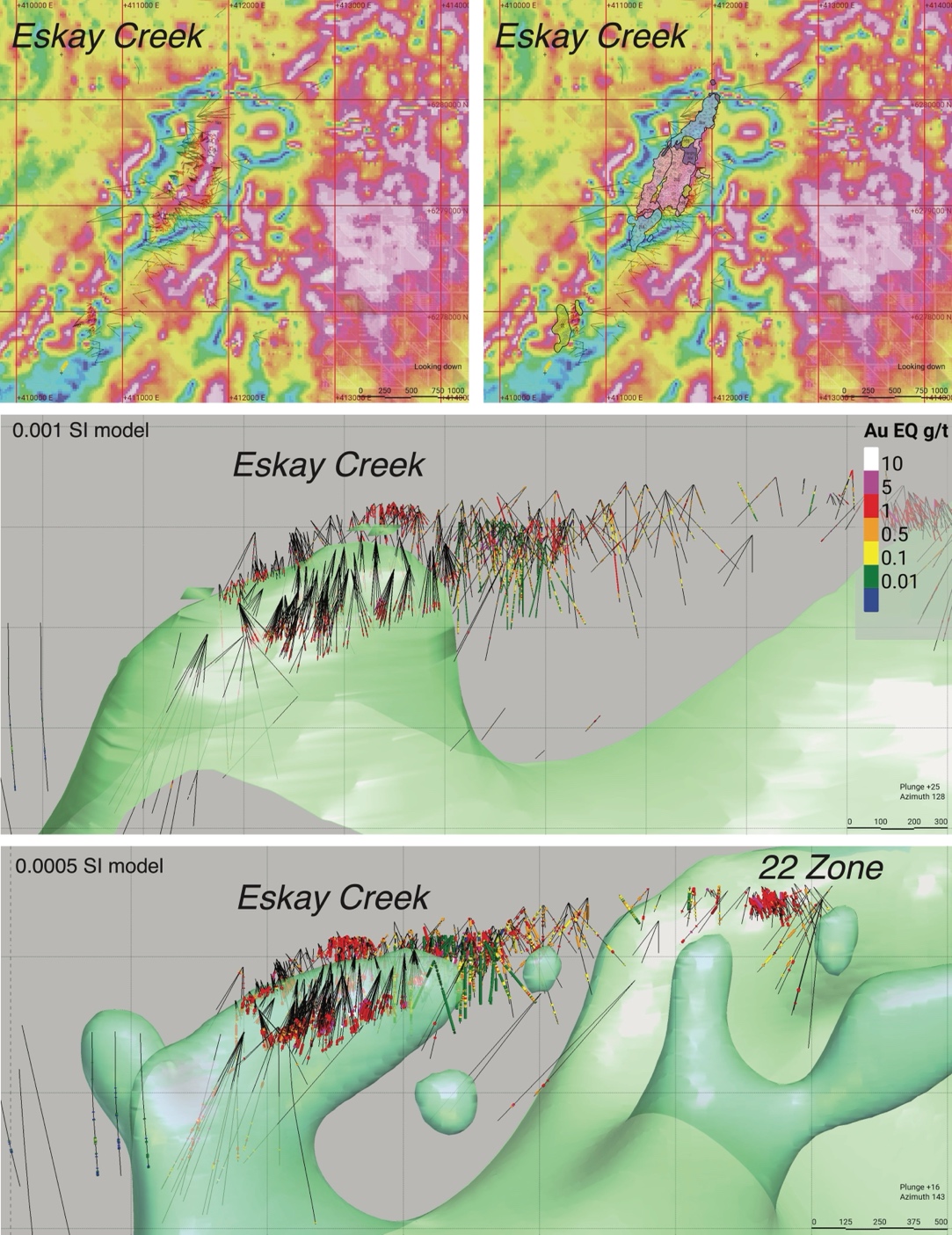
(Figure 1. Results from Simcoe's geophysical analysis of the Eskay Creek deposit. Zones of VMS mineralization at Eskay Creek are clearly defined when applying a magnetic tilt derivative to magnetic data (top images). These data show a distinct bulls-eye pattern associated with the deposit interpreted to result from hydrothermal alteration of host rocks and overprinting during subsequent deformation and metamorphism. The middle image shows a 3D model of a deep-seated magnetic susceptibility anomaly (0.001 SI volume shown in green) associated with the VMS deposit. The lowest image shows a 3D model of the 0.0005 SI magnetic susceptibility volume, showing the anomaly extending to the southwest towards 22 Zone. Gold and silver mineralization is focused along the pronounced deep-seated protrusions in the magnetic susceptibility surface. Eskay Mining can show that this same type of magnetic anomaly occurs with VMS deposits across the Consolidated Eskay property. Drill hole and assay data for Eskay Creek were obtained from publicly available Assessment and NI 43-101 reports, and news releases.)
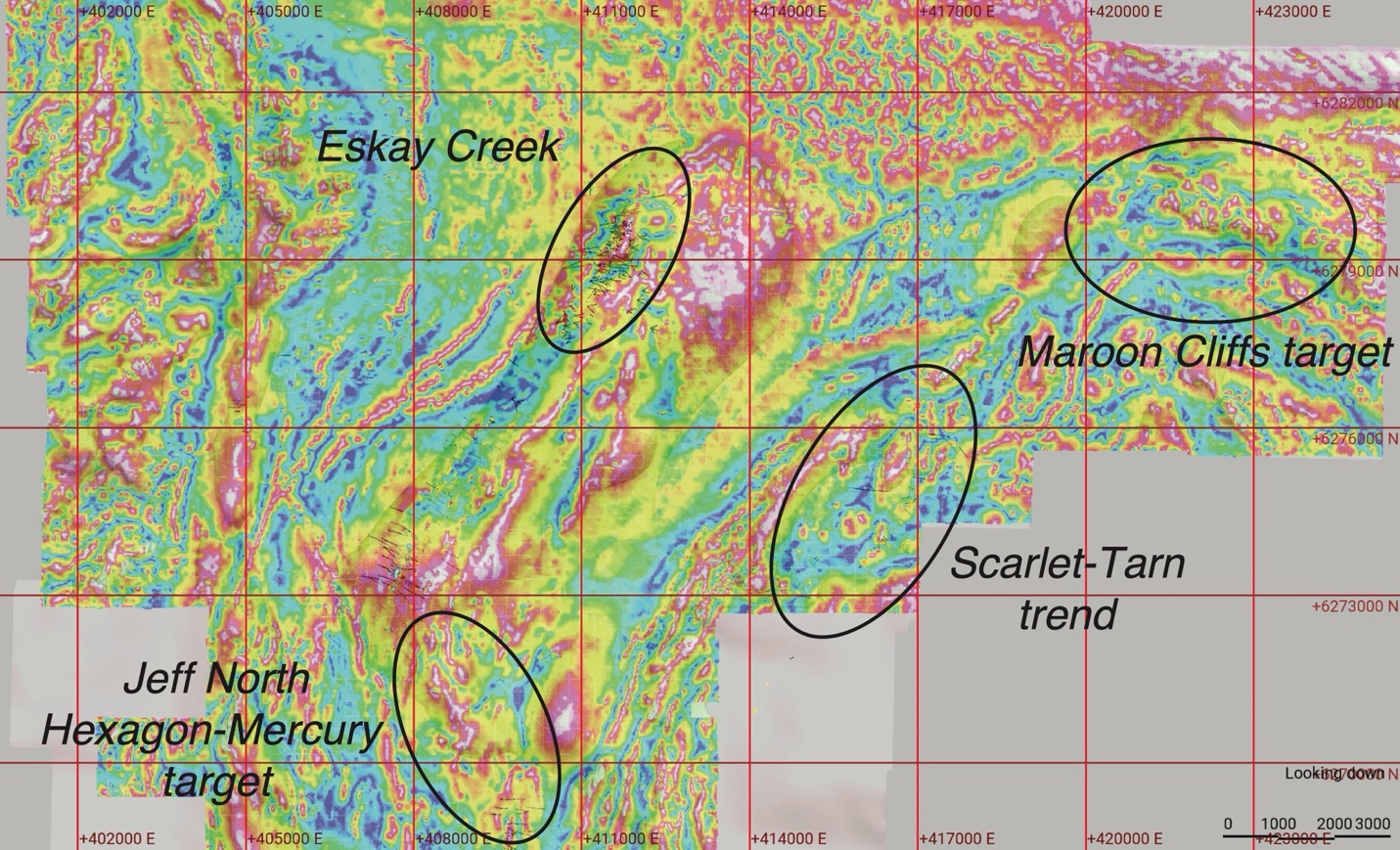
(Figure 2. Preliminary analysis of magnetic data has identified several targets displaying similar signatures to Eskay Creek. Recent exploration work and review of legacy data provide evidence for potential Au and Ag mineralization associated with the three targets noted above. Additional anomalies are associated with areas of known mineralization including TV, Jeff, C10, Cumberland, and Virginia Lakes.)
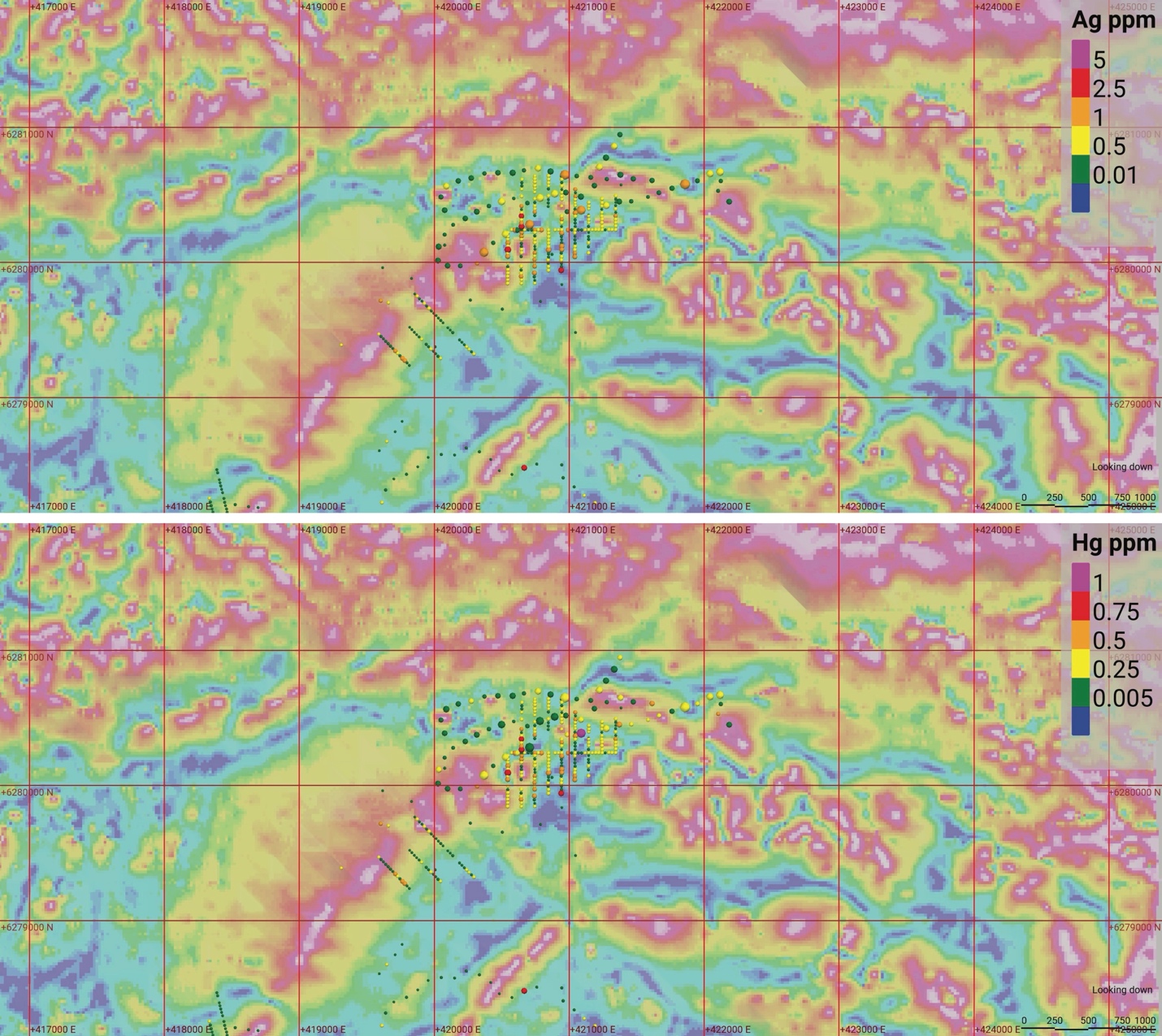
(Figure 3. Recent and legacy soil sample assay results for Ag and Hg covering the western end of the Maroon Cliffs magnetic anomaly. Elevated concentrations of these Au-pathfinder elements coincide with an apparent magnetic anomaly. Exploration of this area in 2023 will include expanded soil and rock chip sampling programs to cover the magnetic anomaly, geological mapping, and drilling if a compelling target is identified.)

(Figure 4. Oblique view of a 2 km thick vertical slice centered on line 6279625 N, showing the magnetic tilt derivative map and the 3D magnetic susceptibility model showing the 0.001 SI volume in light green. The Eskay Creek VMS deposit is associated with a deep-seated zone of elevated magnetic susceptibility that is coincident with a bulls-eye style magnetic anomaly shown by the magnetic tilt derivative data shown in Figure 1. The Maroon Cliffs target is defined by a similar, but larger magnetic anomaly (Figures 2 and 3). Soil sampling and BLEG data in the area (presented below) support the Au and Ag prospectivity of this geophysical target.)

(Figure 5. A map showing Au results from the 2022 BLEG program that was aided by the LiDAR data collected in 2021 allowing better definition of catchment basins. Two very strong BLEG anomalies are located immediately downstream from the Maroon Cliffs magnetic anomaly. This combined with the promising soil results reported above make this a highly prospective target for the 2023 exploration program.)
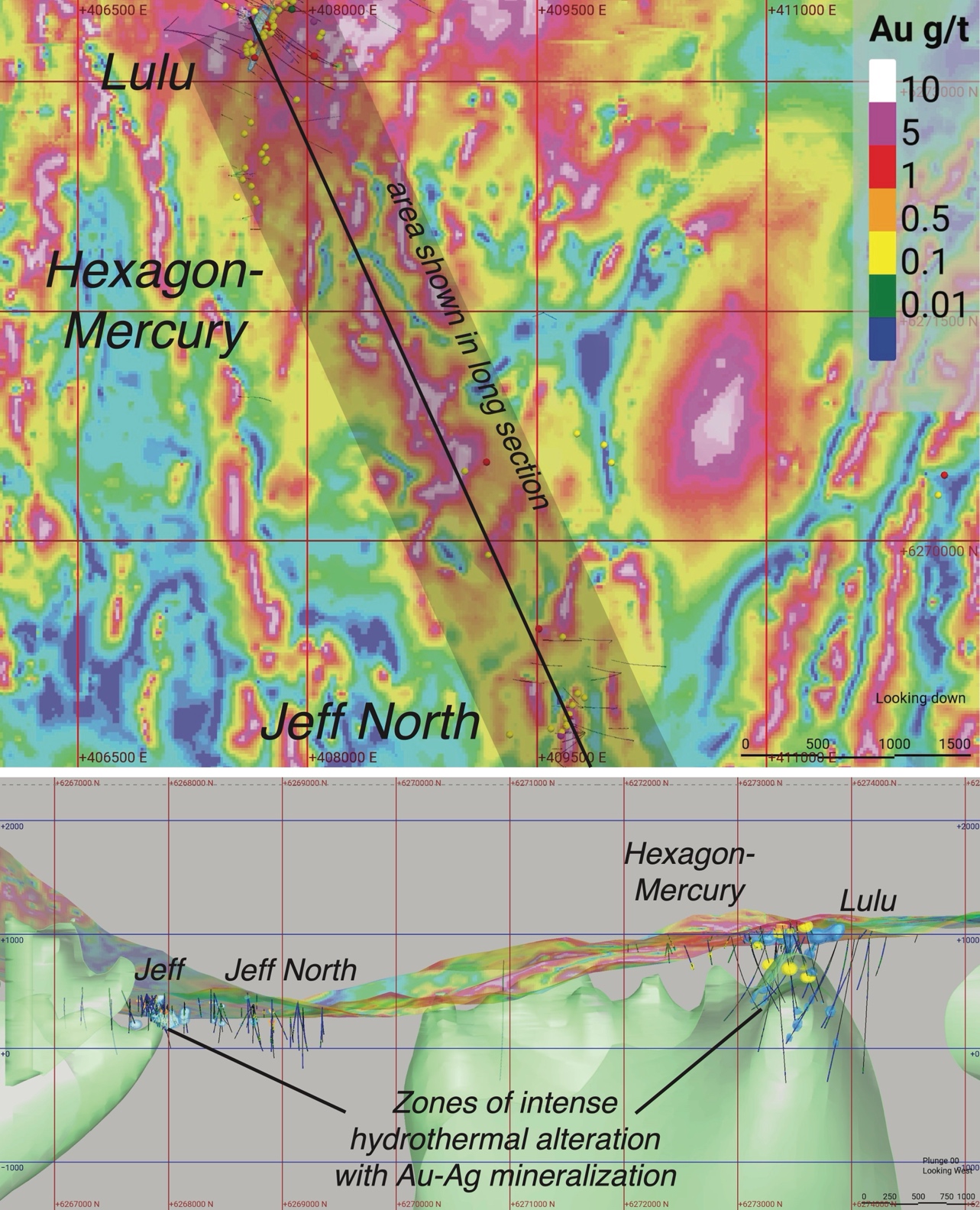
(Figure 6. A 2 km thick vertical slice looking west at the Jeff North-Hexagon-Mercury target. The center line of the slice is oriented along an azimuth of 340 degrees, oblique to the UTM grid and rotated 20 degrees from the viewing plane. The light green volume shows the 0.001 SI magnetic susceptibility 3D model. Zones of intense hydrothermal alteration (an Ishikawa alteration index greater than 80) are modeled as light blue volumes. The area between Jeff North and Hexagon-Mercury hosts prospective magnetic anomalies that lie on trend with Au and Ag mineralization located by drilling and rock chip sampling.)

(Figure 7. Magnetic tilt derivative map (left) and 1000 m thick long sections of the magnetic susceptibility model (right) for the TV-Jeff VMS trend. Long sections are centered around line 409500 E, with the upper one viewed looking due west, and the lower one viewed obliquely and from below the surface. Gold assay results for drill holes, and rock chip samples (circles) are shown. Zones of intense hydrothermal alteration (an Ishikawa alteration index greater than 80) are modeled as light blue volumes in the upper long section. As with Eskay Creek and Lulu, mineralization and hydrothermal alteration are closely associated with protrusions in the modeled magnetic susceptibility volume, with more pronounced protrusions correlating with stronger mineralization at TV and Jeff. The smaller protrusions in magnetic susceptibility between TV and Jeff correspond with zones of anomalous Au and Ag mineralization found with rock chip sampling and drilling. Prospective magnetic anomalism continues to the south and west of TV, supporting the interpretation of our geological team that sulfide mineralization at TV may extend in this direction based on encouraging results from drill holes TV22-108.)

(Figure 8. A 1000 m thick cross-section along line 6265700 N showing the magnetic susceptibility model for the TV VMS showing. Drill core assays in Au equivalent is shown. Zones of intense hydrothermal alteration (an Ishikawa alteration index greater than 80) are modeled in light blue. Mineralization and hydrothermal alteration lie right on the 0.001 SI magnetic susceptibility volume, as is the case with all other VMS systems discussed in this release.)
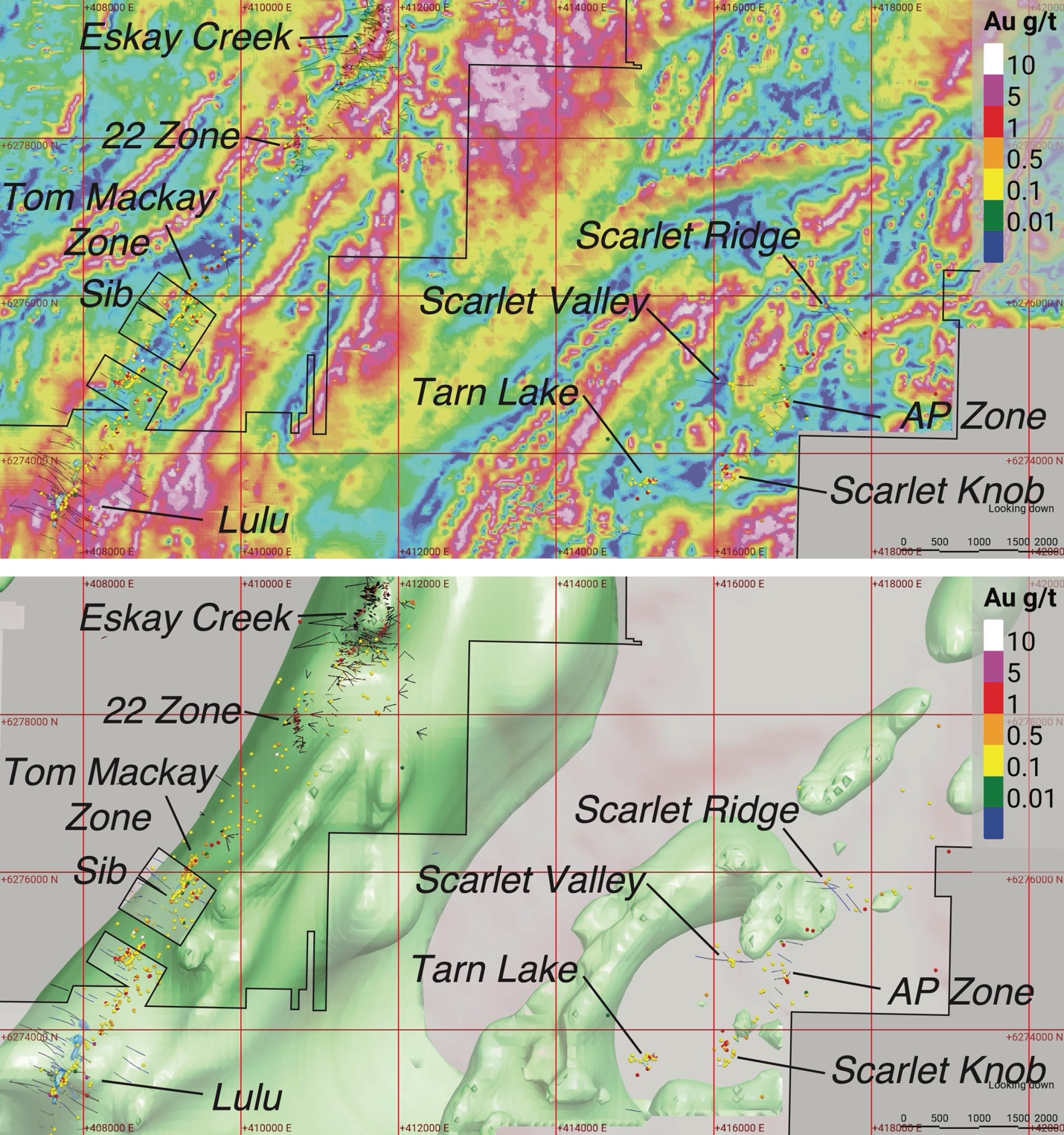
(Figure 9. Magnetic tilt derivative map (top), and 3D model of the 0.001 SI magnetic susceptibility volume for the Scarlet-Tarn and Eskay Creek-Lulu trends. Rock chip assay results from Eskay Creek were obtained from assessment reports in the public domain. As with the other VMS systems described in this release, those on the Scarlet-Tarn trend are associated with low-amplitude magnetic anomalies evident when a tilt derivative is applied to the data and occur along the margins of protrusions in the 0.001 SI magnetic susceptibility volume. Exploration of all the anomalies on the Scarlet-Tarn trend will continue in 2023 with an extensive soil, rock chip, and channel sampling program. The trend of magnetic susceptibility anomalies immediately west of Tarn Lake lie up stratigraphic section and may lie near the inferred Contact Mudstone Horizon. Testing for extensions of the Tarn Lake-Scarlet Knob system will be a major focus of drilling in 2023.
SOURCE: Eskay Mining Corp.
View source version on accesswire.com:
https://www.accesswire.com/743359/Eskay-Mining-Presents-New-Geophysical-Interpretation-of-its-Data-and-Welcomes-Riaz-Mirza-as-Geophysical-Advisor-in-its-Quest-to-Discover-Precious-Metal-Rich-VMS-Deposits-Across-its-Consolidated-Eskay-Project-Golden-Triangle-BC

